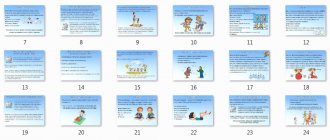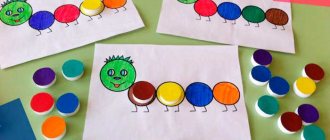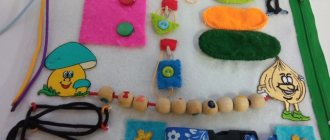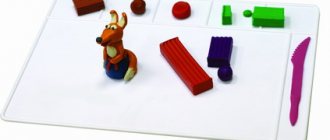Types of games in preschool age
Types of games in preschool age.
The stage of preschool childhood plays a significant role in the manifestation of a child’s creative potential, the awakening of independence, the formation and development of a person’s personality as a whole. The decisive condition for the formation of a child’s individuality is his entry into a special dimension of childhood activity. The leading model of behavior and exploration of the world for a child is, of course, play.
Game is one of those types of children's activities that are used by adults to educate preschoolers, teach them different actions with objects, methods and means of learning. In play, a child develops as a personality, he develops those aspects of his psyche on which the success of his educational and work activities, and his relationships with people will subsequently depend.
In paragraph 2.7 of the Preschool Education Standard, play is defined as a tool for organizing a child’s activities, his multifaceted development in the social-communicative, speech, cognitive, artistic-aesthetic and physical educational areas. The child’s personal psycho-emotional characteristics, his age, abilities and inclinations will determine the meaningful context of the game process.
The fact that the role of play as a leading activity of a preschooler is increasing and that it is given a dominant place is positive, since in recent years, due to social changes in society, computerization, as well as the intensive preparation of the child for school, play is disappearing from the world of childhood. The child’s social world becomes closed, limited to communication with loved ones or virtual communication. Today, preschool education is designed to return cognitive, exploratory, creative play to childhood, in which the child learns to communicate, interact, with the help of which he learns about the world, the relationships of objects and people in this world; a game in which the child “try on” different roles, in which his speech, memory, attention, thinking, emotions, and imagination develop. Thus, the main feature of the organization of educational activities in preschool educational institutions at the present stage is the departure from educational activities, increasing the status of play as the main activity of preschool children.
The tasks of comprehensive education in play are successfully implemented only if the psychological basis of play activity is formed in each age period of early and preschool childhood. This is due to the fact that the development of play is associated with significant progressive transformations in the child’s psyche, and above all in his intellectual sphere, which is the foundation for the development of all other aspects of the child’s personality.
The Federal State Educational Standard for Preschool Education indicates specific features of the gameplay of a preschooler, depending on the age category:
- infant stage (two months - one year) - object play, familiarity with the object world, acquisition of basic skills in manipulating objects, close emotional contact with family;
- early childhood (one to three years) – playing with combined and dynamic toys, communicating and playing with other children under adult supervision;
- preschool period (three to eight years) - a more complex plot-role format of play activity, a communicative game in compliance with certain rules.
It is the teacher who must properly organize games that are not only interesting, but also bring maximum benefit to the comprehensive development and education of preschoolers. The game is dynamic where the management is aimed at its gradual formation, taking into account those factors that ensure the timely development of gaming activity at all age levels. Here it is very important to rely on the child’s personal experience. Game actions formed on its basis acquire a special emotional overtones. The development of a child in play occurs, first of all, due to the varied focus of its content. Play, on the one hand, creates a child’s zone of proximal development and is therefore the leading activity in preschool age. On the other hand, its content is nourished by productive activities and the ever-expanding life experiences of children.
All types of games can be divided into three groups:
- Games initiated by the children themselves (independent games):
- plot-display;
— role-playing game;
- director's production;
- theatrical improvisation.
- Games born on the initiative of adults. Games with a pronounced educational character:
— didactic games with plot drawings;
— an experimental game, a travel game with search elements;
- moving ones of different intensity levels;
— didactic games with musical accompaniment.
- Games that are a form of relaxation or change of activity:
— entertaining games;
— intellectual puzzles and competitions;
— calendar and thematic holidays, carnival performances;
- theatrical costumes;
- folk games and folklore traditions that came to the modern world from the historical past.
Plot-display game
appears from the age of three and precedes a more complex plot and role-playing. The peculiarity of this game is that the child plays alone, the game actions are focused on the toy, but spiritually reflects the world of human relationships, emotions of joy or disappointment, lines of argument or approval, behavior of obedience or rebellion. Thus, the baby does not take on the role in full, but in play actions in relation to the toy he reproduces the model of behavior characteristic of a particular person.
Role-playing games
are a means of all-round development of the child. These are games that children themselves come up with. Games reflect the child’s knowledge, impressions, and ideas about the world around him, and recreate social relationships. This is a game in which children take on the roles of adults, and in game, imaginary conditions specially created by them, they reproduce (or model) the activities of adults and the relationships between them. Each such game is characterized by: theme, game concept, plot, content and role.
Director's play
the least studied phenomenon, it has an exclusively individual character, when a child, acting as a director and screenwriter at the same time, comes up with words for the characters and himself plays their roles, being the author and actor in one person. You can often observe how a child, completely absorbed in building a house or playing with his favorite doll, acts out scenes between fictional characters and, pronouncing their words, does not seem to notice those around him.
Theatrical play is a type of role-playing game. The peculiarity of theatrical play is that over time, children are no longer satisfied in their games only with the depiction of the activities of adults; they begin to be captivated by games inspired by literary works. Based on a literary plot, children act out some scene using costumes or puppet theater characters (floor dolls or bibabo dolls), musical accompaniment or pantomime, choreography can be included, but then the help of adults is necessary. Theatrical and play activities enrich children in general with new impressions, knowledge, skills, develop interest in literature and theater, form dialogical, emotionally rich speech, activate the vocabulary, and contribute to the moral and aesthetic education of each child.
Didactic game
is a verbose, complex, pedagogical phenomenon: it is both a game method of teaching preschool children, and a form of teaching children, and an independent play activity, and a means of comprehensive education of the child. Didactic games contribute to the development of cognitive and mental abilities, the development of children's speech, the replenishment and activation of vocabulary, and the social and moral development of a preschool child.
A didactic game has a certain structure and includes educational and gaming tasks, game action, and game rules. The educational task in them does not appear directly, but is hidden from the playing children, for whom the gaming task comes to the fore. In an effort to realize it, they perform game actions and follow the rules of the game. The content of didactic games and the order of setting didactic tasks are determined by the program. Such games can contain several learning tasks at once.
Independent didactic games also play an important role - these are games that are played in free time. Such games can arise either at the initiative of the teacher or at the request of the children. Then the teacher plays the role of observer and adviser, as well as a participant in the game.
Outdoor games
– conscious, active, emotionally charged activity of a child, characterized by accurate and timely completion of tasks related to the rules that are mandatory for all players. Such games create favorable conditions for the development of active motor activity. Performing actions in an outdoor game is associated with the perception of the environment, with orientation in it, as well as with vivid emotional experiences in a group of peers, as a result of which conditions are created that contribute to the formation of initial forms of self-esteem and self-control of the child.
Using folk games
, educators not only implement the educational and developmental functions of gaming technologies, but also various educational functions: they simultaneously introduce students to folk culture. This is an important area of the regional component of the kindergarten educational program.
Thus, play as a leading activity in preschool age has a significant impact on the development of the child. In the game, all aspects of the child’s personality are formed, a significant change occurs in his psyche, preparing him for the transition to a new, higher stage of development. This explains the enormous educational potential of games. First of all, in play, children learn to communicate with each other and the ability to establish certain relationships with peers. Play, especially collective play, requires the child to mobilize all his strengths and capabilities: both physical and mental. The game makes high demands on the development of a child’s speech: after all, he must explain what and how he would like to play, agree with other children who can play what role, pronounce his text so that others understand it.
By leading the game, organizing the life of children in the game, using game techniques in teaching, the teacher not only creates an optimal environment for ensuring the emotional health of the preschooler, but also influences all aspects of the development of the child’s personality: feelings, consciousness, will and behavior in general, development general abilities, creative imagination, communication skills, to develop the curiosity of preschoolers.
V.A. Sukhomlinsky wrote: “Without play there is and cannot be full-fledged mental development. A game is a huge bright window through which a life-giving stream of ideas and concepts flows into the child’s spiritual world. Play is the spark that ignites the flame of inquisitiveness and curiosity.”
The game has enormous developmental potential, provided it remains an independent activity for children. There is no place for a pedagogical directive in the game, but there is a place for partnership based on deep and sincere respect for the inner world of another, albeit small, person, into which the window with the magical name “Game” helps us look into...
.
Organization of children's games
Plan.
Introduction.
- Characteristics of the game.
- Forms of organization of the game.
- Conditions for organizing the game.
- Possibilities of gaming activities as a developing and educational means.
- Features of game planning in different age groups.
Conclusion
Literature
Application
Introduction.
In preschool age, play is of utmost importance in the life of a small child. The need for play in children continues and occupies a significant place even during the first years of their schooling. In games there is no real conditioning by circumstances, space, time. In play, a child makes discoveries about things that have long been known to adults. Children do not set any other goals in the game than to play.
For preschool children, play is of exceptional importance: play for them is study, play for them is work, play for them is a serious form of education. Play for preschoolers is a way of learning about the world around them.
The need for play and the desire to play in preschoolers must be used and directed in order to solve certain educational problems. The game will be a means of education if it is included in the holistic pedagogical process. By directing the game, organizing the life of children in the game, the teacher influences all aspects of the development of the child’s personality: feelings, consciousness, will and behavior in general.
In the game, the child acquires new knowledge, skills and abilities. Games that promote the development of perception, attention, memory, thinking, and the development of creative abilities are aimed at the mental development of the preschooler as a whole.
- Characteristics of the game.
A game
- the most ancient means of transmitting experience from generation to generation. Long before play became a subject of scientific research, it was widely used as one of the most important means of raising children.
The essence of play, according to L. S. Vygotsky, is that it is the fulfillment of the child’s generalized desires, the main content of which is the system of relationships with adults.1
Gaming activity goes through a long development process. Its elements first appear in infancy, and in preschool, higher forms take shape, in particular, role-playing play.
A characteristic feature of the game is that it allows the child to perform an action in the absence of conditions for actually achieving its results, since its motive lies not in obtaining a result, but in the very process of performing the action.
Game actions are actions free from the operational and technical side, these are actions with meanings, they are of a figurative nature.2
The essence of the game is that in it the child operates with meanings that are divorced from things, but based on real actions.
Thus, children's games are a special type of child activity, embodying his attitude to the surrounding, primarily social reality, and having its own specific content and structure - a special subject and motives for activity and a special system of actions.
- Forms of organization of the game.
The teacher organizes games in three main forms: preparation for the game, its implementation and analysis.
Preparations for the game include
:
- selection of games in accordance with the objectives of education and training: deepening and generalizing knowledge, developing sensory abilities, activating mental processes (memory, attention, thinking, speech), etc.;
- establishing compliance of the selected game with the program requirements for the education and training of children of a certain age group;
- determining the most convenient time for playing the game (in the process of organized learning in the classroom or during free time from classes and other routine processes);
- choosing a place to play where children can play quietly without disturbing others;
- determining the number of players (the whole group, small subgroups, individually);
- preparing the necessary material for the chosen game (toys, various objects, pictures...);
- preparing the teacher himself for the game: he must study and comprehend the entire course of the game, his place in the game, methods of managing the game;
- preparing children for play: enriching them with knowledge, ideas about objects and phenomena of the surrounding life necessary to solve a game problem.
- Games include
:
- familiarizing children with the content of the game, with the material that will be used in the game (showing objects, pictures, a short conversation, during which the children’s knowledge and ideas about them are clarified);
- explanation of the course and rules of the game. At the same time, the teacher pays attention to the children’s behavior in accordance with the rules of the game, to the strict implementation of the rules;
- demonstration of game actions, during which the teacher teaches children to perform the action correctly, proving that otherwise the game will not lead to the desired result (for example, if one of the children is spying when you need to close your eyes);
- determining the role of the teacher in the game, his participation as a player, fan or referee. The degree of direct participation of the teacher in the game is determined by the age of the children, their level of training, the complexity of the game task, and the game rules. While participating in the game, the teacher directs the actions of the players (with advice, questions, reminders);
Summing up the game
- this is a crucial moment in its management, because Based on the results that children achieve in the game, one can judge its effectiveness and whether it will be used with interest in children’s independent play activities. When summing up the results, the teacher emphasizes that the path to victory is possible only through overcoming difficulties, attention and discipline.
At the end of the game, the teacher asks the children if they liked the game and promises that next time they can play a new game, it will be also interesting. Children usually wait for this day. The analysis of the game is aimed at identifying the methods of preparing and conducting it: what methods were effective in achieving the goal, what did not work and why. This will help improve both the preparation and the process of playing the game, and avoid subsequent mistakes. In addition, the analysis will allow us to identify individual characteristics in the behavior and character of children and, therefore, correctly organize individual work with them. Self-critical analysis of the use of the game in accordance with the goal helps to vary the game and enrich it with new material in subsequent work.
Successful management of games primarily involves selecting and thinking through their program content, clearly defining tasks, determining their place and role in the holistic educational process, and interaction with other games and forms of education. It should be aimed at developing and encouraging children’s cognitive activity, independence and initiative, their use of different ways to solve game problems, and should ensure friendly relations between participants and a willingness to help their comrades.
While playing with toys, objects, and materials, small children should be able to knock, rearrange, move them, disassemble them into their component parts (collapsible toys), put them back together, etc. But since they can repeat the same actions many times, the teacher It is necessary to gradually transfer children's play to a higher level.
The development of interest in games and the formation of play activities in older children (4-6 years old) is achieved by the fact that the teacher sets increasingly more complex tasks for them and is in no hurry to suggest play actions. The play activity of preschoolers becomes more conscious; it is more aimed at achieving a result, and not at the process itself. But even for older preschoolers, the management of the game should be such that the children maintain an appropriate emotional mood, ease, so that they experience the joy of participating in it and a sense of satisfaction from solving the tasks.
The teacher outlines a sequence of games that become more complex in content, tasks, game actions and rules. Individual isolated games can be very interesting, but using them outside the system cannot achieve an overall educational and developmental result. Therefore, the interaction between learning in the classroom and in the game should be clearly defined.
For young children, play is the most suitable form of learning. However, already in the second, and especially in the third year of life, children are attracted to many objects and phenomena of the surrounding reality, and intensive assimilation of their native language occurs. Satisfying the cognitive interests of children of the third year of life and the development of their speech require a combination of games with targeted learning in the classroom, carried out in accordance with a specific program of knowledge, skills, and abilities. In classes, methods of learning are also formed more successfully than in games: voluntary attention, the ability to observe, look and see, listen and hear the teacher’s instructions and carry them out.
It should be taken into account that the game requires the right combination of clarity, the words of the teacher and the actions of the children themselves with toys, play aids, objects, etc.
3. Conditions for organizing the game.
Many domestic and foreign psychologists believe that no one will develop a child’s creative abilities better than himself. Therefore, first of all, the child needs to create conditions for spontaneous creative play. We can highlight the main tasks that a teacher faces when leading games:
1) development of the game as an activity;
2) using the game for the purpose of educating the children's team and individual children.
The development of play as an activity means expanding the themes of children's games and deepening their content. In play, children should gain positive social experience, which is why it is necessary that it reflects adults’ love of work, friendship, mutual assistance, etc.
The more organized the game, the higher its educational impact. The signs of a good game are: the ability to play with concentration, purposefully, take into account the interests and desires of your comrades, resolve conflicts amicably, and help each other in difficulties.
However, play can also be a source of formation and negative experience, when the same children act as organizers, take on the main roles, suppressing the independence and initiative of others; the game may reflect the negative aspects of adult life. Educators, while leading the game, must ensure the accumulation of positive experience in social relationships.
The constant expansion of children’s knowledge about the life around them and the enrichment of their impressions is one of the most important conditions for the development of full-fledged play in a particular group of children.
Equally important for the development of role-playing games is the pedagogically appropriate selection of toys and game materials, which creates the “material basis” of the game and ensures the development of the game as an activity.
The selection of toys should be carried out in accordance with the main theme of children's games in a given age group, taking into account the immediate prospects for their development. For children of primary preschool age, a toy is needed that allows them to develop games in the family, kindergarten, etc. In groups of middle-aged and older children, the selection of toys should ensure the development of games on work topics and games that reflect social events and phenomena. When selecting toys, the teacher should take into account the nature of the requirements that children of this age place on a toy.
The teacher, when organizing the storage of toys, must also take into account the development of play activity. In younger groups, it is most advisable to store toys so that they are in the child’s field of vision - in play corners: after all, a toy stimulates the baby’s play intention, so it should be visible and accessible.
Play activities of preschoolers in the light of the Federal State Educational Standard DO Article
Play activities of preschoolers in the light of Federal State Educational Standards for Preschool Education
The stage of preschool childhood plays a significant role in the manifestation of the child’s creative potential, the awakening of independence, the formation and development of a person’s personality as a whole. The decisive condition for the formation of a child’s individuality is his entry into a special dimension of childhood activity. The leading model of behavior and exploration of the world for a child is, of course, play. While playing, the child meets and communicates with other children, learns to make friends and build relationships, imitates adults, masters the unknown, learns what is good and what is bad. Below we will look at what conditions the Federal State Educational Standard prescribes when developing the play activities of preschoolers.
Modern play activities for preschoolers according to the Federal State Educational Standard
Children's games are not games at all, and it is more correct to look at them as the most significant and thoughtful activity of this age.
Michel de Montaigne
In the light of modern requirements, two possible ways of organizing play in kindergarten are identified. The first way lies in the influence of an adult on the content of the child’s story-based game, traditional for domestic pedagogy. In accordance with the second way, play is considered as an activity in which the child has the opportunity to realize his creative potential, that is, not only to reproduce and repeat what others have created, but also to act as a creator himself.
This is when the interaction of an adult with children is built on the basis of partnerships, i.e. the adult acted as the same play partner for the child as the other child. The basic principles of the concept of the gradual formation of ways of playing:
- In order for children to master gaming skills, an adult should play with them.
- starting from an early age and further at each stage of preschool childhood, when developing a child’s gaming skills, it is necessary to orient him to interaction with a peer partner, “provide” him with ways to coordinate actions with partners.
- an adult, playing with children throughout the entire preschool period, must, at each of its stages, develop the game in such a way that the child “discovers” and assimilates specific, gradually becoming more complex ways of constructing one or another type of game.
In paragraph 2.7 of the Preschool Education Standard, play is defined as a tool for organizing a child’s activities, his multifaceted development in the social-communicative, speech, cognitive, artistic-aesthetic and physical educational areas. The Federal State Educational Standard for Preschool Education indicates specific features of the gameplay of a preschooler, depending on the age category:
infant stage (two months - one year) - object play, acquaintance with the object world, acquisition of basic skills in manipulating objects, close emotional contact with family;
- early childhood (one to three years) - playing with combined and dynamic toys, communicating and playing with other children under adult supervision;
- preschool period (three to eight years) - a more complex plot-role format of play activity, a communicative game in compliance with certain rules.
Clause 4.6 of the Federal State Educational Standard for Educational Education stipulates the importance of developing gaming activities in the formation of social and normative foundations of a child’s behavior, as well as in increasing the efficiency of the educational process:
- Awakening interest - the learning process in a playful way entertains, brings pleasure and joy, neutralizes stress, turns knowledge of the world around us and the development of new practical skills into an exciting journey.
- Self-knowledge and self-realization - the baby gets to know his inner world, learns to show initiative, express his opinion in communication, rely on independence in design, make an informed choice of occupation and play partners;
- Forming a culture of cooperation - a joint game helps develop psychological skills of solidarity, teaches collective activity, the ability to hear not only oneself, but also one’s playing partners, is an excellent practical training in the art of conflict resolution and the ability to find a compromise, fosters respect for other people, develops a sense of justice and self-respect;
- Socialization - the child learns to distinguish between real reality and conditional reality (“make-believe”), develops the volitional qualities of self-discipline and understands the need to follow norms and rules;
- Development of communication skills - the baby masters such a tool as speech to solve the problem of mutual understanding and transfer of information.
- Play therapy helps in overcoming difficulties that arise in any area of the child’s activity.
Principles of organizing the game:
- a free form of child activity, excluding coercion, performed for the sake of obtaining positive emotions from the process itself, and not just from the final result of such activity;
- creative character, built on the principle of initiative, original improvisation and originality;
- emotional passion, manifested in the spirit of rivalry and competition;
- following rules that directly or indirectly reflect the logical sequence and meaningful design of the game.
Typology of play activity of preschoolers
Kinds
Games initiated by the children themselves (independent games):
- plot-display;
- role-playing game;
- director's production;
- theatrical improvisation.
Games born on the initiative of adults. Games with a pronounced educational character:
- didactic games with plot drawings;
- experimental game, travel game with search elements;
- moving at different levels of intensity;
- didactic games with musical accompaniment.
Games that are a form of relaxation or change of activity:
- entertaining games;
- intellectual puzzles and competitions;
- calendar and thematic holidays, carnival performances;
- theatrical costumes;
- folk games and folklore traditions that came to the modern world from the historical past.
Standalone game
At the age of three to five years, a child begins to discover the wonderful world of role-playing games, mastering the basics of role-playing, imitating the behavior of a character from the outside world. The basic basis of such a game is the plot; at this age, everyday scenes from family life become favorites. By first mastering the simplest manipulations with objects, later with their symbolic substitutes, then imitating the social roles of adults, the child improves the mechanisms of abstract thinking and undergoes playful practice in studying various models of behavior in society.
Plot-display game
Plot-based play appears from the age of three and precedes more complex plot-role play. The peculiarity of this game is that the child plays alone, the game actions are focused on the toy, but spiritually reflects the world of human relationships, emotions of joy or disappointment, lines of argument or approval, behavior of obedience or rebellion. Thus, the baby does not take on the role in full, but in play actions in relation to the toy he reproduces the model of behavior characteristic of a particular person. At the age of four or five years, the main characters in the game are still toys, but a more vivid emotional embodiment appears in gestures and facial expressions, dynamic poses of the child himself or the object. The so-called game attributes begin to acquire great importance, for example, a car for the driver, a pointer for the teacher, a doctor’s medical gown, a military cap, etc.
Director's play
Director's play is the least studied phenomenon; it has an exclusively individual character, when the child, acting as a director and screenwriter at the same time, comes up with words for the characters and himself plays their roles, being the author and actor in one person. You can often observe how a child, completely absorbed in building a house or playing with his favorite doll, acts out scenes between fictional characters and, pronouncing their words, does not seem to notice those around him.
Theatrical game
Based on a literary plot, children act out some scene using costumes or puppet theater characters (floor dolls or bibabo dolls), musical accompaniment or pantomime, choreography can be included, but then the help of adults is necessary. Such games teach children to read the mood or emotional state of another person by their facial expressions and gestures, develop a sense of empathy, teach them to understand and feel the people around them, and therefore build appropriate behavior. In addition, heroes are usually the fairy-tale embodiment of good and evil, light and dark forces, and as you know, good always defeats evil in the ending of a fairy tale. Such an unconditional victory of good attracts children and becomes the basis for optimism in life, stimulates the desire to imitate positive characters who are the embodiment of honor and nobility.
Role-playing game
For older preschoolers (6–7 years old), it will be important not to turn to a toy, but to communicate with children who play the role of heroes in the game plot. At this age, a child goes beyond everyday stories; he is inspired by larger-scale, “global” projects, for example, flying into space or traveling around the world, building a railway, etc.
Development under the conditions of the Federal State Educational Standard
The complication of a child’s gaming skill goes through three phases: first, adults are the initiators of the game and the authors of the plot plan, then only their prompt is required, and finally, the child improves his gaming skills to the level of complete independence. The child’s rich imagination and creative improvisation will make the game original and varied in its design, and therefore more interesting and exciting. In order for the games to be truly interesting and varied, serious work on the part of adults is required to involve the child in cognitive activity (clause 2.6 of the Federal State Educational Standard for Education). An erudite child with a developed understanding of the world around him for his age is bursting with new ideas, involving new participants in the game and filling it with deep content.
Basic requirements for effective organization and conduct of the game.
Two models of adult behavior:
- the adult is the inspirer, organizer and coordinator of the game based on a pre-prepared plot and available tools;
- the adult joins the spontaneous initiative of the children, occupying an equal position with the other players, and can influence the course of the game in ways common to all. He can suggest a new character, come up with a plot twist, etc.
Tasks of managing children's play activities:
- Stimulate playful reproduction of events in everyday life, thus achieving familiarity with the purpose of objects and mastering the skills of their practical use.
- Help to master the ability to see, understand and formulate the task of the game.
- To teach the search for various options for using toys during the game.
- Encourage the use of symbolic objects that replace real-life objects.
- Create game situations with fictional objects.
- To form the experience of replacing some game actions with images of a verbal form of expression.
- Arouse in children the desire to find different options for solving a game problem, using new combinations with objects.
- Develop independence in making decisions and searching for various tasks and goals of the game.
- Instill a gaming culture, i.e. teach to recognize the right of each participant to their own gaming space and respect the interests of all players.
- Stimulate the expression of keen interest in the games of peers.
- Learn to set a game task yourself and accept the task set by others.
- Encourage the invention of interesting and unusual game ideas.
- Teach the ability to negotiate.
An experiment game is a type of didactic game, an interactive form of conducting an educational lesson, during which visual modeling and imitation of the phenomena being studied are organized. Through experimental and research activities, a child gains new knowledge or acquires skills. “How does sound travel?” With the help of simple devices, such as a bowl of water or a small pool, coins or construction kit parts, the teacher invites children to understand the origin of the physical phenomenon of sound transmission. Children, throwing coins into a container of water, notice wavy circles spreading across the water. The teacher explains that sounds from the interlocutor or from another sound source reach us in the same waves, but through the air.
Rules of conduct for a teacher in the practical implementation of socio-game technology:
- absolutely exclude authoritarianism and dictatorship, except for those situations that may pose a potential danger to the health of children;
- take a democratic position on an equal basis with all participants in joint activities;
- keep a pause of non-interference and silence, such behavior will give children the opportunity to show independence in solving a problem or conflict;
- take into account the real capabilities of children, but try to expand the zones of independence, not chew knowledge and not give ready-made algorithms;
- help the child overcome shyness and uncertainty, having in the pedagogical reserve a set of exercises that will increase self-esteem and give confidence in their own abilities;
- moving away from a clear goal setting, it is more acceptable to create conditions for the discovery of the child’s intellectual and creative potential;
- during the presentation stage, give the first word to low-active children.
Clause 3.3.5 allows the educational organization to independently determine gaming equipment. According to the requirements of the Federal State Educational Standard for Education, the set of toys should be replenished gradually and periodically changed in accordance with the age and life experience of the children.
The skill of a teacher is most eloquently demonstrated in his ability to organize the independent activities of his students. The teacher needs to skillfully direct each child to an entertaining, but at the same time useful game, while it is important to rely on initiative and develop the child’s curiosity. An attentive and caring teacher will correctly distribute children among game tasks so that they do not interfere with each other, and will show sensitivity and fairness in resolving a conflict situation that arises during the game. Thus, the harmonious creative development of children depends on the level of professional training of the teacher.










